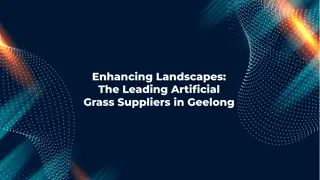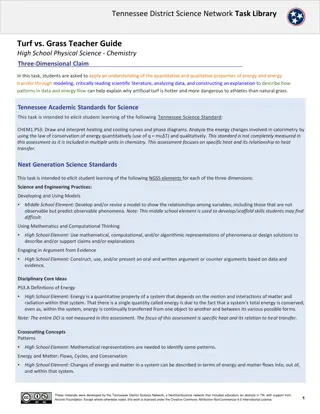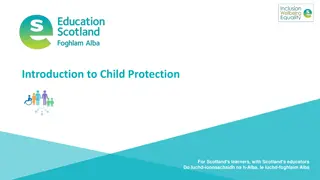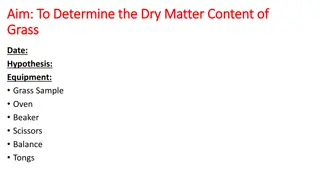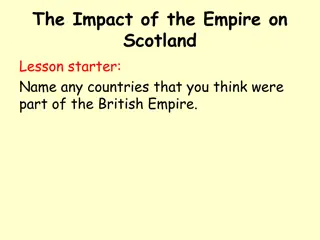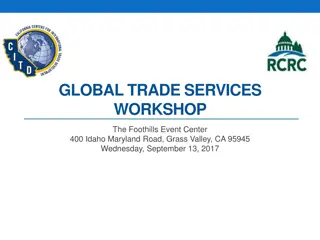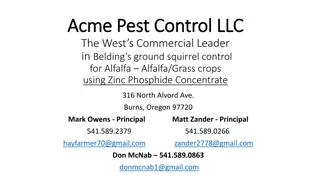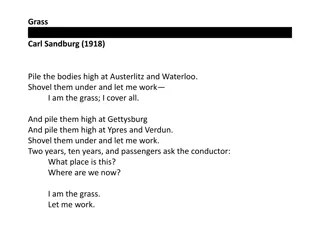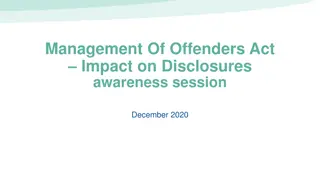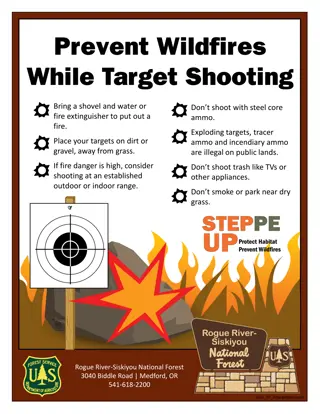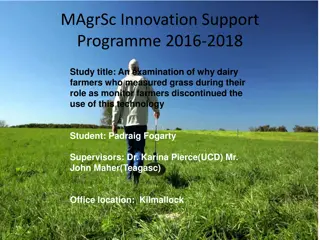Understanding the Vital Role of Grass in Scotland
Grass plays a crucial role in Scotland's agriculture and ecosystem, providing sustenance for livestock, stabilizing soil, reducing carbon footprint, and enhancing biodiversity. With over 80% of Scotland covered in grassland, its importance cannot be overstated. This presentation delves into the various aspects of grass, from its growth cycle to its environmental benefits, showcasing why it is a cornerstone of Scotland's landscape and agricultural practices.
Uploaded on Sep 17, 2024 | 0 Views
Download Presentation

Please find below an Image/Link to download the presentation.
The content on the website is provided AS IS for your information and personal use only. It may not be sold, licensed, or shared on other websites without obtaining consent from the author. Download presentation by click this link. If you encounter any issues during the download, it is possible that the publisher has removed the file from their server.
E N D
Presentation Transcript
GLORIOUS GRASS (Third/Fourth Level)
Session Layout This presentation will cover the following: An introduction to grass The importance of Grass for Scotland How Grass Grows Carbon Sequestration Methane and the Biogenic Carbon Cycle Biodiversity and Grass Grass measuring Calculating Supply of Grass Calculating Demand of Grass How Grass is Measured on Farms Key Points, Summary & Glossary
Introduction to Grass There are lots of different types of grass; it is estimated that there are over ten thousand different species worldwide. Grass is used for recreation (golf, football, rugby etc), amenity (parks and green spaces), domestic (lawns) and in agriculture. Ruminants (animals such as cattle and sheep that have four compartments to their stomach) are unique in that they can consume grass and convert it into energy which can be converted into human protein. For many livestock farmers in Scotland, grass is their most important crop as it is the main feed for cattle and sheep. Many farmers spend a lot of time, money and effort to ensure that they get the most out of their grass crop. DISCUSSION POINT: Do you think Scotland has a good climate for growing grass?
The Importance of Grass in Scotland Over 80% of Scotland is grassland often it is ground that isn t suitable for growing crops, fruits or vegetables but ideal for growing grass. Grass allows Scottish livestock producers to have a lower carbon footprint. Areas of natural heritage are not destroyed in Scotland to make way for grass (unlike rainforest deforestation). Grass is part of Scotland s iconic landscape. Grass provides a natural habitat for wildlife. Grass utilisation reduces dependency on other types of feeding. DISCUSSION POINT: Why does the natural production of grass allow Scotland to have a lower beef production carbon footprint than say, Brazil?
Benefits of Grass Grass does more than just feed animals, in addition it: Provides soil stability and prevents top soil depletion & erosion Reduces flooding Sequesters carbon Provides an ecosystem to many different species Enhances biodiversity both above and below the soil Can reduce the requirements for more costly feeds. Utilising grass can lower a farms carbon footprint. Builds organic matter in soils.
How Grass Grows 1. The grass seed is sown. 2. The seedling germinates and the first leaf appears. 3. Each new leaf grows up encircled by the last one. 4. The oldest leaf is always on the outside and the young expanding leaf in the centre. 5. The seedling plant develops to produce new leaves (number varies depending on species). 6. Leaves continue to be produced but as each new leaf appears, the oldest one dies. 7. Grass plants have the ability to produce tillers (a shoot that grows after the initial parent shoot, possessing its own leaf). Tillering mainly happens in the Spring and Autumn. 8. Tillering continues until plants come into contact with each other, so all the gaps have been filled. Each tiller will live for about a year.
Factors Affecting Grass Growth Factors Affecting Grass Growth: Grass growth begins when the soil temperature is at 5 C and the rate of leaf appearance increases with an increase in temperature. Temperature: Light is essential for providing energy through photosynthesis enabling the grass plant to create new cells and increase cell size which leads to leaf expansion on every tiller. Light: Plant cells need water to expand and without it, growth will slow. Water: Nitrogen stimulates grass growth as it increases leaf production and photosynthesis. The faster the leaves grow, the more light they can use. The plant can find nitrogen from the soil and sometimes farmers will add nitrogen fertiliser (artificial) or natural fertiliser such as dung which contains nitrogen. Nitrogen:
Grass growing slows or stops over the winter so farmers harvest grass in the summer and make it into Silage or Hay to feed animals throughout the winter months. Silage Hay Hay is cut then left to dry in the sun (usually for about a week) then baled and stored under cover. Silage is grass that has been pickled . The grass is cut, then left for a few hours to reduce the moisture content. It is then, either taken to a large pit where it is pressed down (by driving over it in a tractor); or it is made in to bales. Both of which are then covered in plastic. Covering it in plastic keeps the oxygen out which allows the fermentation to take place which maintains the nutrient levels (sugars and proteins).
Carbon Sequestration (Absorption) Carbon sequestration is the process by which carbon is incorporated into the soil through plant intake, lifecycle and decomposition. Soil carbon can be lost rapidly due to disturbances, including cultivation (ploughing/preparing the soil for growing crops). There are ways that farmers can increase their land s carbon capturing capacity ie. Rotational grazing and reducing cultivation. It can take many years for organic matter to become stabilised in soil and up to 100 years for soil to return to it s pre-disturbed carbon stock. Sequestration rates are rapid to begin with but get progressively slower over time.
Methane (CH4) As cattle and sheep are ruminants they produce methane as a natural bi-product. The methane that comes from cattle and sheep (and wetlands) is called biogenic methane. Biogenic methane: is a natural bi-product of ruminant enteric fermentation (mainly cows/sheep s burbs) makes up around 40% of a farm s emissions, depending on farm type. is around 28 times more potent than CO2. lasts for approximately 12 years in atmosphere. Is a flow gas (it is recycled). For more information on the other carbon emissions produced from livestock farming visit the To Field section of Farming Foodsteps.
The Biogenic Carbon Cycle Biogenic carbon is the emission related to the natural carbon cycle. The Biogenic Carbon Cycle centres on the ability of plants to absorb and sequester carbon. Plants have the unique ability to remove carbon dioxide (CO2) from the atmosphere and release oxygen into the atmosphere photosynthesis. When plants perform photosynthesis, carbon is primarily converted to cellulose, a form of carbohydrate. Cellulose is particularly high in grass which is indigestible to humans but suitable for feeding livestock. Source: UC Davis CLEAR Center
Biodiversity & Grass Grazing practices can have a positive or negative impact on biodiversity. Grass and grazing management has an impact on the following: Insects (including pollinators) Farmland birds & waders (such as lapwing and curlew) Soil biodiversity Wild Animals Positive Impacts: Livestock grazing is crucial in encouraging and maintaining biodiversity. Without maintaining a low level of grazing across grasslands, species-rich grasslands are replaced by taller, wild grasslands with lower species diversity. This was demonstrated when agricultural subsidies transitioned to area payments, leaving much grassland unmanaged, and resulting in a sharp decrease in biodiversity. Negative Impacts of Overgrazing: (Overgrazing occurs when plants are exposed to intensive grazing for extended periods of time, or without sufficient recovery periods) Overgrazing reduces moisture capture allowing for run-off and flooding. Degrades the availability for biodiversity. Overgrazing can kill the plant. Overgrazing reduces the leaf available to capture sunlight and reduces the ability to capture carbon.
Grass Measuring Many farmers measure grass so they can figure out how much grass they have on the farm their supply. They will then work out how many animals they have to feed and what stage they are at their demand. The unit of measurement for measuring grass is Kg of dry matter per hectare. With that information they can then work out if they have enough grass to feed the animals and if so, for how long. If they don t have enough grass they can source alternative feeds or adjust their stock numbers to meet supply. DISCUSSION POINT: Did you know farmers measured their grass? What do you think they use to take the measurements?
Experiment: How to Measure Grass Measure the grass in the school playground, the playing fields, a garden or in the park. What you need: A ruler A flat board (a clipboard, stiff cardboard or a plastic lid something that will level the grass when laid on it but not push it down too much). Notebook & pen The Sward data set (next slide) Method: 1. Select several different sample areas (if there are long patches of grass, don t measure all of the long patches, measure a fair representation of the area). 2. Lay the board flat (don t push it down) on the sample area. 3. Use the ruler to measure the height from the ground to the bottom side of the board. 4. Take a note of the height of the grass. 5. Repeat the process until you get a fair representation of the sample area/field. 6. Once you have a list of the measurements, work out an average for the sample area. 7. Compare your measurement to the data set below to work out the Kg/DM/Ha.
Grass Growing Data Set *Data from QMS Sward Stick Cm Spring (Mar-Apr) Summer (May-Aug) Autumn (Sept-Nov) Winter (Dec-Feb) 15 3250 3930 4210 3050 14 3130 3740 3970 2890 13 3010 3550 3720 2730 12 2880 3350 3480 2580 11 2750 3150 3240 2420 10 2620 2960 3000 2260 9 2470 2750 2750 2100 8 2320 2540 2510 1940 7 2150 2330 2270 1780 6 1980 2110 2020 1620 5 1780 1880 1780 1460 4 1580 1650 1540 1300 3 1340 1400 1290 1140 2 1050 1120 1050 990 1 680 800 810 830
Quality of Grass It s not just the quantity of grass that farmers measure they also assess the pasture quality. Pasture quality describes its nutritional value. This is a combination of the portion of the plant that can be digested (digestibility) and is directly related to the energy that can then be used by the animal (Metabolisable Energy - ME). The nutrition, digestibility and palatability of grass changes as it matures. Young grass is rich and nutritious and higher in protein. Young leaves have the highest nutritive value, followed by stem, with dead material having the lowest energy value. Mature, stemy grass has a much lower energy value. Once it has gone to seed (mature) it is less palatable. However, if grass is overgrazed, it has to start the growth stage all over again and takes much longer to recover.
How Grass is Measured on Farm Farmers use several different tools to manage grass on farm: Sward stick similar to the ruler and board method on previous slides. Rising plate meter includes electronic, manual and Bluetooth Dragged pasture meter goes behind a quad bike to measure grass Weather station can help measure ground temperature, rainfall & soil temperature. App/mobile phone Software Scissors, bag & scales
How to Calculate Demand The unit of measurement used to measure grass is kg of dry matter per hectare this is the weight of dry feed per hectare of land which is available for livestock to graze. Dry Matter: Dry matter is the proportion of the grass which remains after all the water content is removed. Hectare: Unit of area in the metric system equal to 10,000 square metres (the equivalent of 2.47 acres, an international rugby pitch or 1.86 football pitches). Different animals have different feeding demands, and demands change depending on their age and stage (see next slide). Cattle and sheep don t eat centimetres of grass, they eat kg of dry matter. Information that you will need to calculate demand: Stock type and their allocation which is worked out as a % of bodyweight see next slide Number of animals Weight of animals
Stock Type & Allocation Data Set *Data from QMS Sward Stick Stock Type Dry ewes of cows Mid-pregnancy ewes or cow Mature rams of bulls Late lactation cows Late pregnancy ewes or cows Finishing cattle Early to mid-lactation ewes Mid or late lactation ewes Replacements Growing cattle Early lactation ewes Flushing ewes or cows Allocation (% of bodyweight) 2% 2.5% 3% 4% Growing lambs
Working out Feed Demand Supply = the amount of grass available. Demand = the amount of grass required. Here s an example based on 40 growing cattle weighing 400 kg each. 1. There are 40 animals 2. The growing cattle weigh 400 kg and require 3% of their bodyweight (400 x 3% = 12) 3. Multiply the two numbers together to get the demand per day Demand = 40 x (400 x 3% = 12) = 480 kg DM per day Demand = no. of animals x (weight x feed allocation) = kg DM per day animals require You can now put this knowledge to the test in the Glorious Grass Worksheet where there are grazing scenarios for you to try.
Key Points Ruminants (animals such as cattle and sheep that have four compartments to their stomach) are unique in that they can consume grass and convert it into energy which can be converted into human protein meat. Over 80% of Scotland is grassland often it is ground that isn t suitable for growing crops, fruits or vegetables but ideal for growing grass. Grass provides soil stability, prevents top soil depletion and reduces flooding. Factors that impact grass growth are water, light, nitrogen & temperature. Farmers also harvest grass and make it into Silage or Hay to feed animals through the winter. Carbon sequestration is the process by which carbon is incorporated into the soil through plant intake, lifecycle and decomposition. When plants perform photosynthesis, carbon is primarily converted to cellulose (particularly high in grass), a form of carbohydrate. Good livestock grazing is crucial to encouraging and maintaining biodiversity, however overgrazing can have a negative impact on biodiversity. Feeding grass reduces farmers costs and reliance on feeds which usually reduces their carbon footprint. The unit of measurement used to measure grass is kg of dry matter per hectare this is the weight of dry feed per hectare of land which is available for livestock to graze.
Glossary of Terms Biodiversity Bulls Carbon Sequestration Dry Matter Dung The existence of a wide variety of plant and animal species living in their natural environment. Male cattle used for breeding. The process by which carbon is stored in the soil through plant intake, lifecycle and decomposition. Dry matter is the proportion of the grass which remains after all the water content is removed. Dung is faeces from animals, especially from large animals such as cattle often it is mixed with the bedding (i.e. straw) that has been used to house the animals. A female sheep that has had a lamb. Cattle that are being fattened (finished) for market/slaughter. Ewes that are getting some rich grass to ensure they are in prime condition for mating. To cause seeds to sprout or form new tissue following increased metabolism. Grazing or grazing land is land on which animals graze eat grass. Unit of area in the metric system equal to 10,000 square metres. The equivalent of 2.471 acres. Lactation is the production of milk by female mammals during the period after they give birth. Animals such as cattle, pigs and sheep which are kept on a farm are referred to as livestock. The energy (in this case from the grass) that can be used by the animal. Ewe Finishing Cattle Flushing Ewes Germinate Grazing Hectare Lactation Livestock Metabolisable Energy (ME) Paddocks A small field (often a larger field is sub-divided into smaller paddocks).
Glossary of Terms (cont.) Pasture Photosynthesis Pasture is land with grass growing on it for farm animals to eat. The synthesis of organic compounds from carbon dioxide and water (with the release of oxygen) using light energy absorbed. A male sheep used for breeding. Livestock that is purchased to replace animals which have died or been sold. The remaining, left over (the grazing residual is the grass that is left). A tool used to measure the quantity of pasture in a paddock. To use an RPM, you walk across a paddock taking plate meter readings. The shifting of livestock to different units of a pasture in regular sequence to permit the recovery and growth of the pasture plants after grazing. The first compartment of the stomach of ruminants, behind the reticulum, in which food is partly digested before being regurgitated as cud. Any mammal that chews the cud and has a stomach of four compartments, one of which is the rumen. The group includes deer, antelopes, cattle, sheep, and goats. Turf or grass the grasses, weeds, organic matter that make up the soil covering. A tool used to measure the length of a sward/grass. A shoot that grows after the initial parent shoot, possessing its own leaf. Ram/Tup Replacements Residual Rising Plate Meter Rotational Grazing Rumen Ruminant Sward Sward Stick Tiller * Definitions collated from Collins Dictionary and QMS own knowledge.
Content prepared by the Health & Education Team at Quality Meat Scotland For further information contact: education@qmscotland.co.uk








